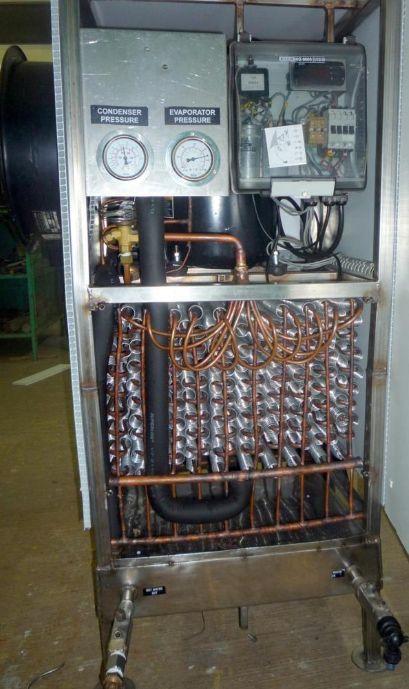The invention relates to a wire fin and tube heat exchanger designed for enhanced thermal performance and durability. It comprises a heat exchange tube made of a high thermal conductivity material, over which one or more helically wound wire fins are disposed along its length. The wire fins, made of a springy, thermally conductive material, maintain continuous thermal contact with the tube, with portions of each turn freely supported for efficient heat transfer. The tube is inclined at an angle between 0° and 30° to the horizontal to optimize performance.
There is a need for deposit forming heat exchangers that are simple to manufacture, cost effective, reliable, flexible, versatile in use, have high heat transfer efficiency, and can be used continuously for a long period.
- Frost-Resistant Design: The optimized spacing and intermediate size of wire fins reduce frost bridging, enabling longer continuous operation (20+ hours) without defrosting.
- Enhanced Heat Transfer Efficiency: The freely supported helically wound wire fins create turbulence and promote mixing of external fluid flow, significantly increasing heat transfer rate and surface contact area, leading to improved thermal performance over prolonged use.
- Free-Floating Wire Fin: There is no physical bonding between fin and tube which allows thermal contact with flexibility for expansion/contraction.
- High External Fluid Flow Efficiency: The large spacing between wire fins and tubes reduces pressure drop, improves mixing, and prevents clogging from condensate.
- Vibration-Assisted Self-Cleaning: Small vibrations improve deposit shedding, ideal for dusty or contaminated environments.
The prototype of the deposit-forming wire fin and tube heat exchanger comprises a heat exchange tube made from high thermal conductivity materials such as aluminum, copper, iron, nickel, titanium, or their alloys. The tube is set at an angle between 0° to 30° relative to horizontal. A springy, helically wound wire fin is freely supported over the tube, with thermal contact at discrete points. The fin has a cross-sectional area ranging from 0.2 mm² to 20 mm², optimally between 0.8 mm² to 4 mm². Fin pitch ratio ranges from 1.05 to 40, and fin length ratio from 1.05 to 64, with preferred values between 2.2 to 20 and 2 to 3, respectively. The wire fin and tube can have various cross-sectional shapes, such as circular, oval, or triangular. A heat transfer aid cum corrosion-resistant outer layer such as alkyd or epoxy resin, ceramic, zinc, or chromium may be applied via painting, coating, or electroplating.
A different version of this technology is used in the Evaporator Ice Bank for the storage of a cooling effect in milk coolers. Also, this type of heat exchanger was used in an Air Source Heat Pump for sub-zero operating conditions to heat tap water from 25°C to 75°C in a once-through mode with refrigerant condenser integrated with thermal storage.
4
This heat exchanger design enhances energy efficiency and operational longevity in various thermal systems, reducing downtime, maintenance costs, and energy consumption. Its frost-resistant and self-cleaning characteristics make it ideal for critical applications in cold climates, contaminated environments, and industrial systems.
- VAC (Heating, Ventilation, and Air Conditioning)
- Heat pumps for heating air/water in sub-zero ambient
- Freeze concentration of milk, sugarcane juice, other juices and liquids like medicinal preparations, tea, coffee, etc.
- Thermal engineering
- Process engineering
- Energy and power generation
- Refrigeration and cold chain systems
- Food processing
- Waste heat recovery systems
- Cement and construction materials
Geography of IP
Type of IP
3062/MUM/2012
391500

